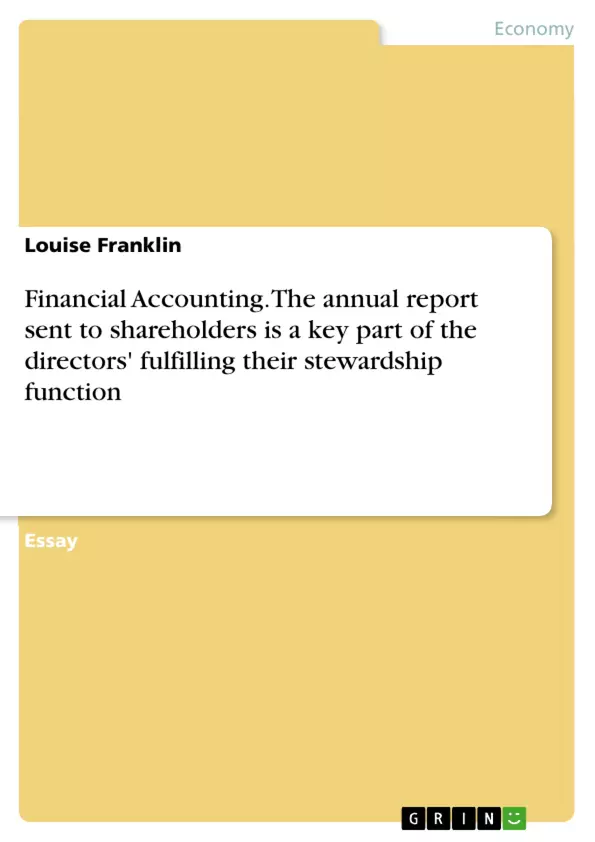The annual report that a company must send to its shareholders is a key part of the directors’ fulfilling their stewardship function. Explain this to a shareholder who has just received their company’s latest annual report.
Areas covered include;
•the nature of financial reporting
•the function of the four financial statements-statement of comprehensive income, statement of financial position, statement of cash flow and the statement of changes in equity.
•the function of the supporting notes, with particular reference to the disclosure of accounting policies and their role within the overall report.
•the ways in which financial information provided to shareholders is regulated in the UK with reference to the reasons for the major shifts in the UK regulatory framework in the last twenty years.
•effectiveness in maintaining investor’s confidence in published annual reports.
•identifying which, in your opinion, has been the most significant development to affect the regulatory framework in recent years. Give reasons.
Inhaltsverzeichnis (Table of Contents)
- Financial Reporting and Stewardship
- Annual Reports and Stewardship Assessment
- Financial Statements
- Statement of Financial Position
- Statement of Comprehensive Income
- Statement of Changes in Equity
- Statement of Cash Flows
- Supporting Notes and Stewardship Assessment
- The Regulatory Framework
- Legislation
- Accounting Standards
- Stock Exchange Regulations
- The Enron Scandal and its Impact
- Creative Accounting and its Consequences
- The Importance of a Conceptual Framework
- IAS 17 - Leases
- The Controversy of IAS 17
- Off-Balance Sheet Financing
- The Need for Uniformity and Transparency
- The Revision of IAS 17
- Conclusion
Zielsetzung und Themenschwerpunkte (Objectives and Key Themes)
This text explores the crucial role of financial reporting in providing shareholders and stakeholders with relevant and reliable information for informed decision-making. The text highlights the importance of the stewardship function, where company directors are entrusted to manage the company's affairs responsibly and transparently. It examines the relationship between the annual report and the assessment of stewardship performance, emphasizing the value of financial statements and supporting notes in providing a comprehensive understanding of the company's financial health and operations. Here are some key themes explored in the text:- The importance of financial reporting for informed decision-making by shareholders and stakeholders
- The stewardship function of company directors and their responsibility to provide accurate and transparent financial information
- The role of the annual report in assessing stewardship performance
- The limitations and potential for misrepresentation in financial reporting
- The need for a standardized conceptual framework to enhance comparability and reduce the potential for manipulation
Zusammenfassung der Kapitel (Chapter Summaries)
The text begins by explaining the concept of stewardship and its importance in the context of shareholder relationships. It emphasizes the reliance shareholders have on directors to manage company resources effectively, leading to growth, profitability, and survival. The text then introduces the four main financial statements: the statement of financial position, the statement of comprehensive income, the statement of changes in equity, and the statement of cash flows. Each statement is described in detail, highlighting its purpose and key elements, including examples of how these statements can be used to assess financial stability, profitability, and cash flow dynamics. The text also emphasizes the importance of supporting notes in providing qualitative information that complements the numerical data presented in the financial statements. It explores the role of these notes in enabling shareholders to understand accounting policies, methods, and justifications for certain financial decisions. The text then examines the regulatory framework surrounding financial reporting, highlighting the role of legislation, accounting standards, and stock exchange regulations in ensuring the quality and comparability of financial information. The Enron scandal is discussed as a prime example of how poor financial reporting and manipulation can lead to significant consequences for stakeholders, causing a loss of confidence in the financial system. This event serves as a catalyst for the need for greater transparency and accountability in financial reporting, leading to the introduction of new legislation and regulations, such as the Sarbanes-Oxley Act. The text also explores the potential for creative accounting and income smoothing, highlighting the need for continuous improvement in standards to prevent manipulation and ensure faithful representation of company performance. The text concludes by focusing on the controversial impact of IAS 17 - Leases, particularly the shift towards a commercial substance over legal form approach. It outlines the challenges and controversies surrounding this standard, including its potential for both positive and negative consequences in terms of transparency, accounting practices, and the assessment of stewardship performance.Schlüsselwörter (Keywords)
The core focus of this text lies in the areas of financial reporting, stewardship function, annual reports, financial statements, accounting standards, regulatory framework, corporate governance, and transparency. These are the key terms that encompass the central concepts and themes explored, encompassing the importance of accurate and reliable financial information, the role of directors in managing company resources, the need for robust accounting standards and regulations, and the impact of corporate scandals on the financial system.- Citar trabajo
- Louise Franklin (Autor), 2011, Financial Accounting. The annual report sent to shareholders is a key part of the directors' fulfilling their stewardship function, Múnich, GRIN Verlag, https://www.grin.com/document/203876



